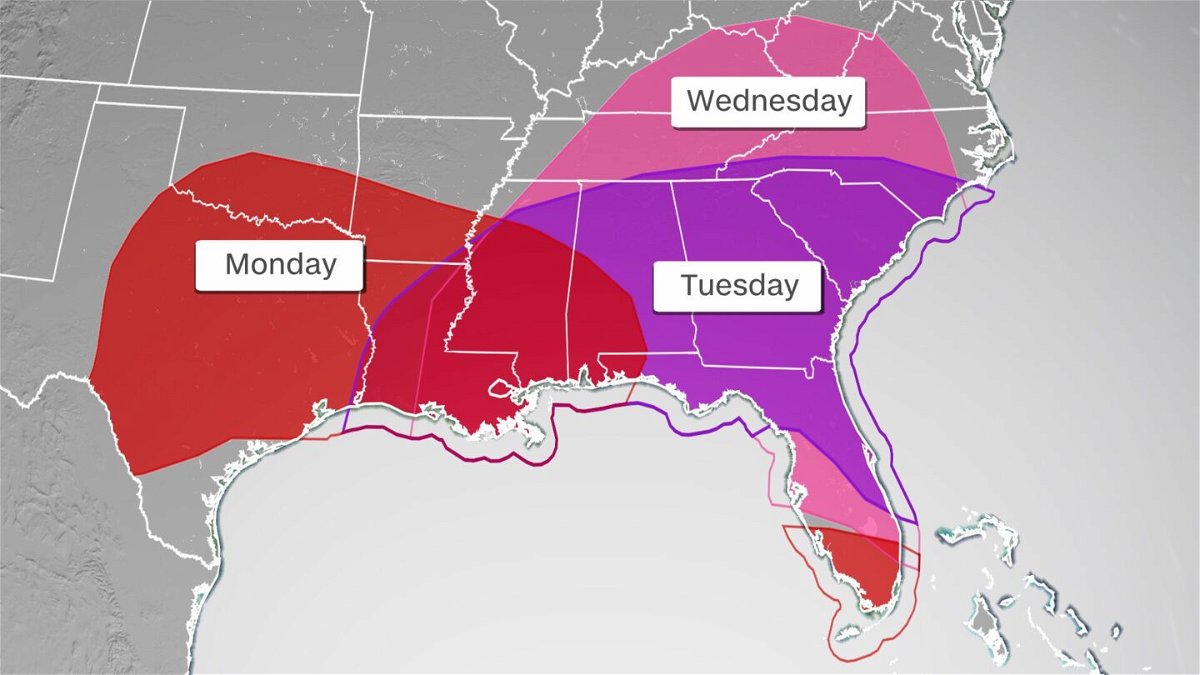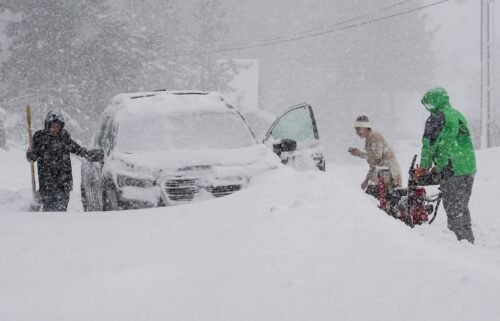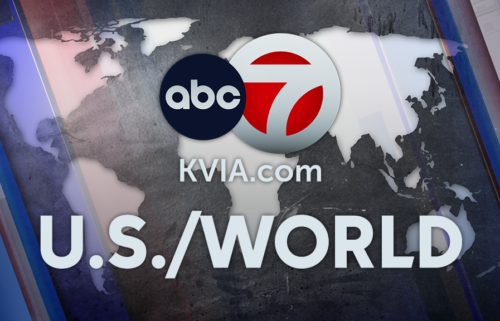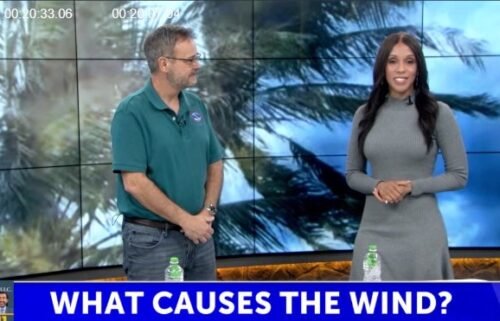Round three of tornadoes coming to the South

More than 10 million people are at a Level 3 risk for severe weather on April 4.
By Jennifer Gray, CNN
As we enter our third week in a row with the potential for severe weather, it’s starting to feel a bit like a broken record.
It’s not only the third week in a row with the potential for severe weather, but it’s also happening in the same places over and over.
Is it just sticking out in our minds because the first round caught our attention with the deadly EF-3 tornado that hit outside of New Orleans? Or is there more to it?
How to set up severe weather alerts on your phone
Often, weather systems follow patterns, so this severe weather potential in the same areas may be more common than you might think.
We reached out to the Storm Prediction Center and talked with Bill Bunting, the chief of forecast operations, about the storms returning to the same areas lately.
“The atmosphere has a fairly chaotic component to it, but it does occasionally get into patterns where we see this repeatability. We’ve seen it in all seasons,” said Bunting. “Unfortunately, for this past month, and certainly for the week ahead, the threat for severe weather is going to be present again, in many of the same areas that have already seen enough severe weather just over the past four weeks.”
He pointed out the severe weather week after week has a strong connection to the placement of the jet stream, which creates the conditions for repetition.
“These types of weather patterns typically feature strong southwesterly winds in the mid-levels and strong southeast to southerly winds near the surface. That creates a natural environment for wind shear that is favorable for organized thunderstorms and tornadoes,” Bunting explained.
In addition, Bunting mentioned the very moist air flowing northward from the Gulf of Mexico, which has helped the storms develop over the last few weeks, is once again what we will see this week.
Read about how a thunderstorm produces a tornado
The storm timeline
This week is shaping up to be a classic severe weather event.
“Moisture from the Gulf of Mexico will begin to surge north toward the southern tier states and converge with the cold front slowly moving into the southern Plains,” wrote the Weather Prediction Center (WPC). “This will lead to a steady expansion of showers and thunderstorms from the southern Plains into the Deep South over the next couple of days.”
The SPC highlighted an area including more than 10 million people for a Level 3 out of 5 risk for severe weather today.
The “enhanced” area includes Dallas, Shreveport and Jackson. However, even Baton Rouge, New Orleans, San Antonio and Houston could all see storms.
“Damaging wind gusts, large to very large hail, and tornadoes will all be possible,” the SPC outlined in its forecast discussion about Monday’s severe weather threat.
By Tuesday, the threat shifts to the east, yet still includes some of the same cities as today. New Orleans, Baton Rouge and Jackson will still be under the threat for severe weather Tuesday, since the storms will be arriving during the overnight hours tonight into tomorrow.
But we will also add Montgomery, Savannah and Charleston, which will be under a Level 3 out of 5 “enhanced” risk for severe weather.
The National Weather Service (NWS) office in New Orleans was bold in its forecast discussion.
After two weeks of severe weather, they started by saying, “Bottom line up front … strong to severe thunderstorms possible late Monday night and Tuesday morning.”
They went on to say, “All modes of severe weather possible, with the wind threat currently being emphasized.” While the wind threat will be the biggest threat, tornadoes can’t be ruled out.
“A swath of damaging wind gusts and several tornadoes are possible,” the SPC noted in its forecast discussion.
By Wednesday, a separate system will form, bringing another round of storms to the South and extending the severe threat for a third day.
“A second system develops on the heels of the first as an upper trough deepens strongly and digs down across the central Plains and eventually the Deep South,” said the NWS office in Atlanta.
Wednesday’s threat will once again be a Level 3 out of 5 “enhanced” risk of severe weather.
This threat area encompasses more than 10 million people and includes Atlanta, Birmingham and Chattanooga.
By Thursday, the threat diminishes, as the storms push off the East Coast. While the system is primarily bringing storms to the South, we will still see rain Thursday for much of the Eastern Seaboard.
Anywhere from Florida to New England will see rain, so we could see a few travel delays at some major airports Wednesday, and again Thursday, as this system moves through.
“Straight hodographs imply a primarily wind-driven threat for any severe storms that develop, but care will need to be taken to monitor this event as it enters the short term,” said the NWS office in Atlanta.
Hodographs are diagrams which represent the changing direction and speed of wind with height.
When will the parade of storms come to an end
It’s impossible to say whether this will be the last week for this region to get hit with strong storms, or if there will be a fourth week.
“Unfortunately, there’s no real predictive skill, looking at March and saying what does that portend for the rest of the season,” Bunting acknowledged. “We’ve seen cases in the past where the pattern has shifted abruptly. And while we can look ahead with that, it’s hard to really predict the seasonal nature of it.”
When you look at the bigger weather picture, we do have a diminishing La Niña, “and those often result in a very active season,” Bunting confirmed.
La Niña is an oceanic-atmospheric phenomenon where cooler than normal sea surface temperatures occur in the eastern Pacific, near the equator.
It impacts weather all over the world, even resulting in a more active storm season in the South.
“So, there are a number of reasons to think that the risk of severe storms is not going to diminish anytime soon,” Bunting emphasized, adding, “We’re moving into the peak of the season.”
Sigh … Indeed, we are. Peak season for tornadoes across the whole US is April through June.
For the record books
While tornadoes can happen any month of the year, tornado season in the South specifically runs from March through May, so we are just getting started.
During May and June, the tornado threat starts to shift more into the southern Plains, including Texas, Oklahoma and Kansas.
If tornado season already has your head spinning a bit, there’s a reason.
“No matter how you slice it, March 2022, will go down as one of the most active Marches in recent memory,” Bunting stated.
In fact, March set a record for the number of tornadoes.
It’s the second year in a row the country has endured a record number of tornadoes in March, solidifying a trend toward more severe weather earlier in the year and raising questions among scientists, who’ve historically seen such weather peak from April to early June.
You can read more about it here.
Severe weather in the Southeast is much more dangerous than other places, mainly because many of the storms strike during the nighttime hours while people are sleeping and don’t have alerts on their phones turned on.
Also, because the Southeast can be rather hilly and is full of trees, you can’t see the tornadoes coming like you can in the Plains.
Read more about why the Southeast tornadoes are more deadly and why scientists are studying these storms more than ever here.
The-CNN-Wire
™ & © 2022 Cable News Network, Inc., a WarnerMedia Company. All rights reserved.
CNN meteorologist Haley Brink contributed to this article.




